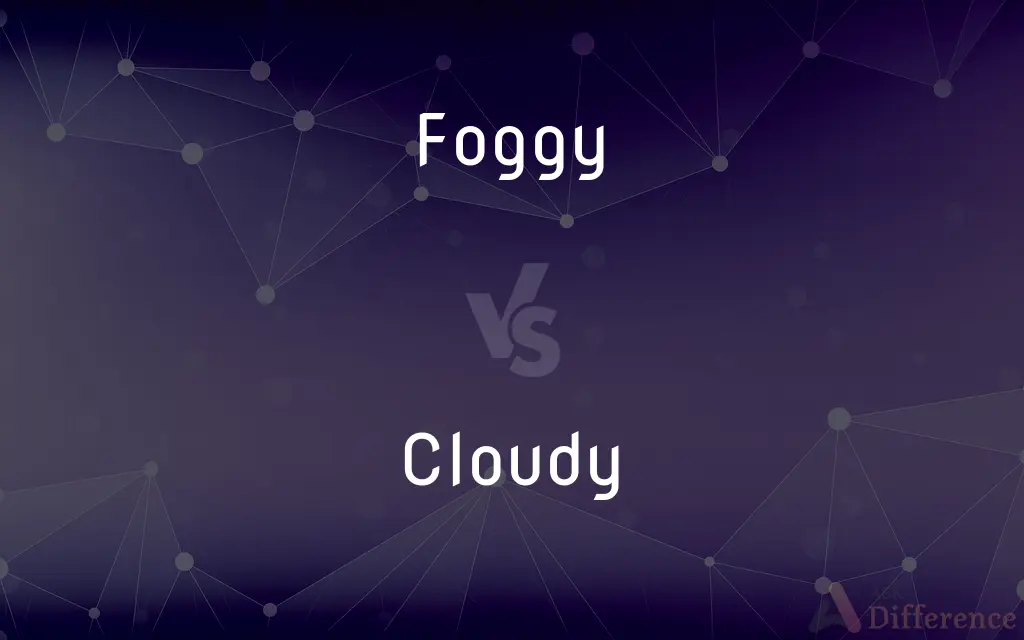Foggy vs. Cloudy — What's the Difference?
By Tayyaba Rehman & Urooj Arif — Updated on March 14, 2024
Foggy conditions involve low-lying clouds at ground level, reducing visibility significantly, while cloudy skies are covered with clouds higher up, not necessarily affecting ground visibility.

Difference Between Foggy and Cloudy
Table of Contents
ADVERTISEMENT
Key Differences
Foggy weather is characterized by clouds that have descended to ground level, leading to reduced visibility on the earth's surface. This phenomenon typically occurs under conditions of high humidity and cooler air temperatures, which cause the water vapor in the air to condense into tiny droplets that hang close to the ground. Whereas, cloudy conditions are defined by the presence of clouds in the sky at various altitudes, which may or may not affect visibility or weather conditions on the ground. Cloudiness is determined by the type, thickness, and coverage of clouds in the atmosphere.
Fog often results in a misty view, making it difficult to see beyond a few meters. This can significantly impact activities such as driving, aviation, and shipping, where visibility is crucial for safety. On the other hand, cloudy weather can range from light cloud cover, which slightly dims sunlight, to overcast conditions, where the cloud coverage is so extensive that it can lead to a significant reduction in daylight and a noticeable drop in temperature. However, cloudy skies do not directly impede horizontal visibility as fog does.
The formation of fog involves a delicate balance of humidity, temperature, and air movement, where cooler air interacts with warm, moist air near the Earth's surface. This interaction causes the water vapor to condense into fine droplets, forming fog. In contrast, clouds form when water vapor rises into the cooler layers of the atmosphere, condenses into water droplets or ice crystals, and becomes visible as clouds. The process is influenced by atmospheric conditions, altitude, and the presence of particles around which water droplets can condense.
Foggy conditions are more common in areas near water bodies, valleys, and places where warm and cold air masses meet. This is because these areas are more prone to the rapid cooling of surface air, leading to condensation and fog formation. Conversely, cloudy conditions can occur almost anywhere and are influenced by broader weather patterns, such as the movement of high and low-pressure systems, making them a more universal weather phenomenon.
While foggy weather is typically a local and often temporary condition that can clear up with the rising sun or a change in air temperature, cloudy skies can persist for longer periods. Cloudy conditions are associated with frontal systems and weather disturbances that can last for days, affecting larger geographical areas. This distinction highlights the transient nature of fog versus the potentially more stable and widespread nature of cloudy weather.
ADVERTISEMENT
Comparison Chart
Visibility
Significantly reduced at ground level
Not directly affected at ground level
Altitude of Phenomenon
At ground level
High in the sky
Weather Impact
Can impact driving, aviation, shipping
May affect light levels and temperatures
Formation Conditions
High humidity, cooler temperatures
Water vapor condensation at higher altitudes
Typical Duration
Often temporary and local
Can last longer and affect wider areas
Common Locations
Near water bodies, valleys
Anywhere, influenced by weather patterns
Impact on Daylight
Does not affect daylight directly
Can significantly reduce daylight
Compare with Definitions
Foggy
Having a blurred or obscured clarity.
The glass became foggy with condensation.
Cloudy
Covered with or characterized by clouds.
The sky was cloudy but it didn't rain.
Foggy
Full of or resembling fog.
The forest looked eerie and foggy at dawn.
Cloudy
Full of or resembling clouds.
We watched the cloudy swirls of cream in our coffee.
Foggy
Characterized by a dense layer of water droplets suspended near the ground.
The morning was so foggy that I couldn't see the other side of the street.
Cloudy
Not clear or transparent.
The water in the pond was cloudy.
Foggy
Confused or unclear thinking.
I felt foggy after waking up from the nap.
Cloudy
Marked by gloom or pessimism.
His mood was as cloudy as the sky.
Foggy
Causing dampness or damp conditions.
The foggy weather made the evening feel colder.
Cloudy
Indicating a risk or threat of trouble or bad weather.
The forecast predicts cloudy conditions with a chance of thunderstorms.
Foggy
Full of or surrounded by fog.
Cloudy
Full of or covered with clouds; overcast.
Foggy
Resembling or suggestive of fog.
Cloudy
Of or like a cloud or clouds.
Foggy
Clouded or blurred by or as if by fog; vague
Had only a foggy memory of what happened.
Hasn't the foggiest idea how to get home.
Cloudy
Marked with indistinct masses or streaks
Cloudy marble.
Foggy
Obscured by mist or fog; unclear; hazy
Cloudy
Not transparent, as certain liquids.
Foggy
(figuratively) Confused, befuddled, etc.
He was still foggy with sleep.
Cloudy
Open to more than one interpretation.
Foggy
Being, covered with, or pertaining to tall grass etc that grows after, or is left after, cutting; moss
Cloudy
Not clearly perceived or perceptible.
Foggy
Filled or abounding with fog, or watery exhalations; misty; as, a foggy atmosphere; a foggy morning.
Cloudy
Troubled; gloomy
His future at the company is cloudy.
Foggy
Beclouded; dull; obscure; as, foggy ideas.
Your coarse, foggy, drowsy conceit.
Cloudy
Covered with or characterised by clouds; overcast.
Foggy
Filled or abounding with fog or mist;
A brumous October morning
Cloudy
Not transparent or clear.
Foggy
Stunned or confused and slow to react (as from blows or drunkenness or exhaustion)
Cloudy
(of fruit juice) Containing pith
Foggy
Indistinct or hazy in outline;
A landscape of blurred outlines
The trees were just blurry shapes
Cloudy
Uncertain; unclear.
Foggy
Obscured by fog;
He could barely see through the fogged window
Cloudy
Using or relating to cloud computing.
A cloudy infrastructure
Cloudy
Shady; sketchy; suspicious
Cloudy
Overcast or obscured with clouds; clouded; as, a cloudy sky.
Cloudy
Consisting of a cloud or clouds.
As Moses entered into the tabernacle, the cloudy pillar descended.
Cloudy
Indicating gloom, anxiety, sullenness, or ill-nature; not open or cheerful.
Cloudy
Confused; indistinct; obscure; dark.
Cloudy and confused notions of things.
Cloudy
Lacking clearness, brightness, or luster.
Cloudy
Marked with veins or sports of dark or various hues, as marble.
Cloudy
Lacking definite form or limits;
Gropes among cloudy issues toward a feeble conclusion
Nebulous distinction between pride and conceit
Cloudy
(of especially liquids) clouded as with sediment;
A cloudy liquid
Muddy coffee
Murky waters
Cloudy
Full of or covered with clouds;
Cloudy skies
Common Curiosities
What causes foggy conditions?
Foggy conditions are caused by the condensation of water vapor near the ground when cool air comes into contact with warmer, moist air.
What is the primary difference in the formation of fog and clouds?
The primary difference is altitude: fog forms at ground level due to condensation of water vapor in cool air, while clouds form at higher altitudes when water vapor condenses.
Are there different types of clouds associated with cloudy weather?
Yes, there are several types of clouds (e.g., cirrus, cumulus, stratus) that vary in altitude, appearance, and weather implications.
Do foggy conditions affect air travel?
Yes, foggy conditions can significantly impact air travel by reducing visibility for takeoff and landing operations.
How do fog and clouds affect outdoor activities?
Fog can hinder outdoor activities requiring visibility, while cloudy weather might only affect light levels and temperatures, making it more comfortable for some activities.
Why does fog usually disappear after sunrise?
Fog often dissipates after sunrise as the temperature rises, causing the water droplets to evaporate back into the air.
How do geographic locations influence the frequency of fog?
Areas near water bodies, in valleys, or where warm and cold air masses meet are more prone to fog formation.
Can fog occur during any season?
Yes, fog can occur in any season, but its formation depends on local conditions like humidity, temperature, and geographical features.
Is it possible to have fog and clouds at the same time?
Yes, it’s possible to have fog on the ground with clouds above, especially in complex weather systems.
How does cloudy weather differ from foggy weather in terms of visibility?
Cloudy weather affects the sky and may reduce daylight but doesn’t usually impact horizontal visibility at ground level, unlike fog, which significantly reduces visibility.
How do weather forecasts predict foggy conditions?
Forecasts use temperature, humidity data, and local geographical features to predict when foggy conditions are likely to occur.
Can cloudy skies lead to precipitation?
Yes, depending on the type and thickness of the clouds, cloudy skies can lead to various forms of precipitation, like rain or snow.
A basement is a partially or fully underground floor in a building, often used for living space or storage, while a cellar is specifically designed for storage, particularly of wine or food.
Concise Explanation
Can cloudy weather affect mood?
Yes, prolonged cloudy weather can affect mood, often leading to feelings of gloom or lethargy in some individuals.
Can foggy and cloudy conditions coexist with air pollution?
Yes, both fog and clouds can capture and hold pollutants, sometimes worsening air quality, especially in urban or industrial areas.
User
Basement vs. Cellar
LocationPartially or fully below ground levelFully underground
Light and AccessMay have windows and external accessLimited or no windows, often limited access
Definitions with Example Sentences
Basement
The terminology and usage of basements and cellars can vary by region and culture, with some using the terms interchangeably or attributing different characteristics to them based on local building practices and traditions. Despite these variations, the fundamental distinction lies in their intended use and design features, with basements serving a broader range of functions within the home, and cellars focused on storage and preservation.
Structured Comparison Table
GPT
Brief Comparison
AspectBasementCellar
Primary UseVersatile: living space, storage, utilitiesStorage, especially wine and food
Temperature ControlDepends on use; may have insulation and heatingDesigned for optimal temperature and humidity for storage
Real Estate ValueCan significantly increase living space and property valueAdds value for specific uses but not generally living space
Climate ControlVariable, may be climate-controlled if used as living spaceTypically features natural or enhanced climate control
Common FeaturesMay include bedrooms, bathrooms, officesShelving for wine or food, sometimes tasting areas for wine
A floor of a building partially or entirely below ground level. e.g., They converted their basement into a spacious family room.
Space within a building used for varied purposes, including storage and living. e.g., Our basement houses both a guest bedroom and a utility area.
What is the primary difference between a basement and a cellar?
The primary difference lies in their use; basements are versatile spaces for living or storage, while cellars are specifically designed for storage, particularly of wine or food.
Can cellars be used for purposes other than wine or food storage?
While primarily for storage, cellars can be adapted for other uses, such as root cellars for vegetables or as secure storage areas, but they are generally not used as living spaces.
Why might someone choose not to finish a basement?
Reasons might include cost, the desire to use it solely for utilities and storage, or concerns about moisture and flooding.
How do cellars maintain optimal storage conditions?
Cellars use natural underground temperatures and may incorporate humidity control systems to maintain conditions ideal for the storage and aging of wine and food.
What are some safety tips for driving in foggy conditions?
Use low-beam headlights, reduce speed, and increase following distances to navigate safely in foggy conditions.
A basement refers to a floor of a building that is partially or fully below the ground level. Basements can serve a variety of purposes, from being finished living spaces, such as family rooms, offices, or bedrooms, to areas designated for utilities and storage. This versatility makes basements a common feature in many homes, especially in regions where they provide a practical foundation and temperature regulation benefits. On the other hand, a cellar is a type of basement specifically intended for the storage of wine, food, or other perishables. Cellars are typically fully underground to take advantage of the cooler, more stable temperatures found below the earth's surface, which are ideal for preservation purposes.
While basements can be adapted for various uses, including recreational activities or additional living quarters, cellars are often less accessible and not designed as living spaces. This distinction highlights the functional differences, where basements are integrated into the daily lives of the inhabitants, and cellars are more utilitarian. Conversely, cellars, especially wine cellars, may be designed with a focus on humidity and temperature control to optimize the storage conditions for their contents.
The construction and design of basements often incorporate windows and external access, providing natural light and an additional exit or entrance in case of emergencies. These features contribute to making basements more habitable and versatile. In contrast, cellars, being primarily storage spaces, usually lack windows and may have limited access, focusing instead on maintaining an optimal environment for the goods stored within.
In terms of real estate value and home functionality, a well-designed basement can significantly enhance a home's living space and property value, offering additional areas for entertainment, bedrooms, or home offices. Cellars, while valuable for specific uses such as wine collection or safe food storage, do not typically contribute to the home's total living space and may not have the same broad appeal or value addition in the real estate market.
DesignCan be finished to match the rest of the homeUtilitarian, focused on storage needs
AccessibilityOften designed for regular use or occupancyPrimarily for occasional access
Area designed for additional functionality beyond the main living spaces. e.g., The basement serves as both a home theater and an office.
The lowermost part of a building, often used for storage or as a foundation. e.g., The house's basement was built to withstand floods.
A subterranean level offering potential for expansion of living space. e.g., They planned to remodel the basement to add two more bedrooms.
Cellar
A room or storage space below ground level, primarily for wine or food. e.g., The restaurant's cellar contains a vast collection of vintage wines.
An underground chamber used for preserving perishable goods. e.g., We store our home-canned vegetables in the cellar to keep them cool.
A space designed to maintain a constant cool temperature for storage. e.g., Their wine cellar is temperature-controlled to ensure the wine ages perfectly.
Part of a building specifically used for storage needs, not living space. e.g., The old farmhouse had a cellar used exclusively for storing potatoes and apples.
A facility dedicated to the storage and aging of wine. e.g., They visited the vineyard's cellar to sample and buy wine.
FAQs
Can a basement be converted into a living space?
Yes, basements can be converted into living spaces such as bedrooms, family rooms, or home offices, provided they meet building codes and regulations.
Why are cellars ideal for wine storage?
Cellars provide the cool, stable temperatures and controlled humidity ideal for aging wine properly.
Do all homes have basements or cellars?
Not all homes have basements or cellars; their presence depends on geographic location, climate, and construction practices.
How does a basement add value to a home?
A well-designed basement increases a home's usable living space and can significantly enhance property value.
Is it more expensive to build a basement or a cellar?
Costs vary based on construction complexity, intended use, and location, but basements designed for living space can be more expensive due to the need for finishes, insulation, and possibly additional plumbing and electrical work.
What are the construction requirements for a basement?
Construction requirements for basements include proper insulation, ventilation, waterproofing, and compliance with local building codes, especially for egress windows and doors.
Share Your Discovery

Previous Comparison
Empyema vs. Emphysema
Next Comparison
Diagram vs. SchemeAuthor Spotlight
Written by
Tayyaba RehmanTayyaba Rehman is a distinguished writer, currently serving as a primary contributor to askdifference.com. As a researcher in semantics and etymology, Tayyaba's passion for the complexity of languages and their distinctions has found a perfect home on the platform. Tayyaba delves into the intricacies of language, distinguishing between commonly confused words and phrases, thereby providing clarity for readers worldwide.
Co-written by
Urooj ArifUrooj is a skilled content writer at Ask Difference, known for her exceptional ability to simplify complex topics into engaging and informative content. With a passion for research and a flair for clear, concise writing, she consistently delivers articles that resonate with our diverse audience.
















































